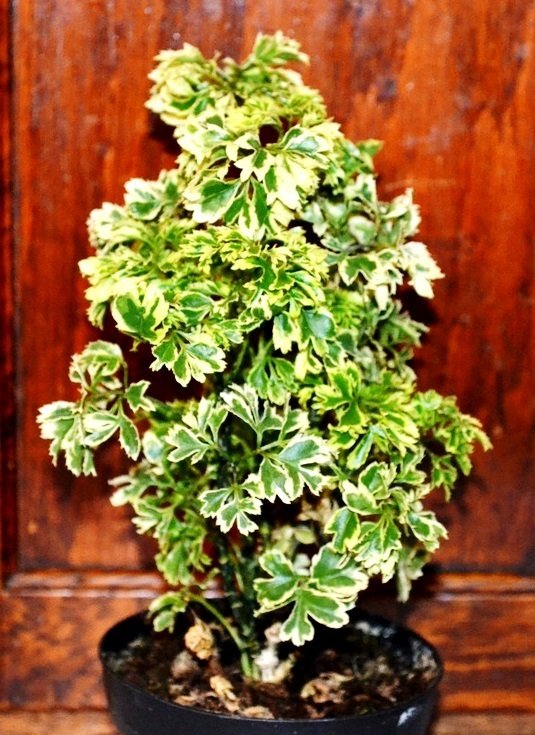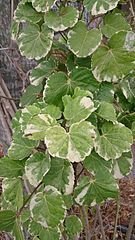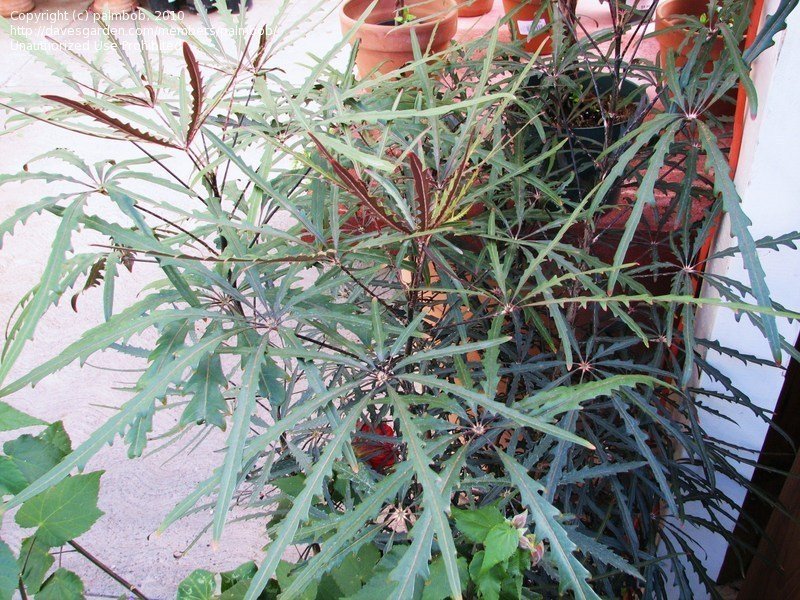





If one of your gardening friends mentions a houseplant called "aralia," ask "which one?" There are at least three indoor tropicals called aralia. All are lovely foliage plants. They all belong to the same plant family. Let's look at Ming, dinnerplate, and false aralias which are making appearances as small potted plants or included in combination floral planters.
The name "aralia" isn't reserved for just one specific plant. Aralia, in casual usage, is any plant from a big and diverse family, Araliaceae. The family is worldwide, and has members that are tropical shrubs, vines, thorny trees, and medicinal herbs. What I'd like to introduce today are three plants that you may see in a greenhouse (though not frequently) or find included in a mixed floral planter: Ming aralia, dinnerplate aralia, and false aralia.
At right: dinnerplate aralia leaf, photo from Plantfiles
All three of these have very pretty foliage. At first glance, though, you'd hardly guess they are closely related. Remember, it's by the flower structure, not the leaf shape, that we decide who's a cousin to whom in the plant world. They are sold sometimes in quite small pots, or as medium potted plants or even small indoor trees. And they share a similar habit, tending to stay narrow and upright. They are happy in a wide range of lighting and average household temperatures. Despite the assets, these aralias are not among the best beginner houseplants. They have a fussy reputation, and many owners comment about unexplained leaf drop. Some of the problems with aralias over the years are due to mass production leading to poor quality nursery stock. These are plants for the intermediate gardener who wants to give the plant some thoughtful attention.With an eye to good care, many people are quite pleased with their aralia houseplants.
Here are the three in more detail: 
At right: variegated ming aralia, photo by DG subscriber HollyAnnS
The "ming" name may be a vague reference to the Asian origin of this species. This aralia has ruffley compound leaves on light colored "trunk." One variety has been called "parsley aralia" and it does look a bit like parsley growing on a very small tree. The foliage and stems are well proportioned on this plant, so it has a tree like form at any size. The picture at right shows a variegated (leaves having white or yellow markings) Ming aralia.The all green types are just as lovely.
At right: dinnerplate aralia, photo from Wikipedia 
Dinnerplate aralia is closely related to the Ming, in the same genus. But dinnerplate has very round leaves on thin stems. This gives it a unique look. I suppose, wth imagination, they seem like serving plates that would display fancy hors d'oeuvres. They are grown from stem cuttings, so you'll see it as a rooted chunk of stem with several sprouts. One kind of dinnerplate has been called Geranium aralia, though the confusion compounds here because it is really a Pelargonium (zonal geranium) that the plant closely mimics.
Call it what you like from the above names, it is still a real Aralia, from the same family as the other plants here. False aralia has lacey, dark green, sometimes nearly black leaves. The thin graceful leaves grow in clusters as they do on its cousin, the common Schefflera umbrella tree. As a small to medium sized tropical, false aralia has a lovely lacey look, made even prettier by the dark leaf color. These narrow leaves found on houseplant size specimens are the juvenile leaf style. In maturity the leaves become wider and bigger. The false aralia then looks almost like a Schefflera with serrated leaves. In southernmost Florida and other tropical zones, this plant is grown outside, and leaflets grow to 12 inches.
At right: false aralia, photo from Plantfiles 
As mentioned above, these three aralias would be prized specimens for an intermediate gardener. Give them a warm, humid indoor location. They are said to adapt to most light levels, except for strong sunlight. They are said to like some air circulation. According to this guide to indoor plants from the Missouri Botanical Garden, the dinnerplate aralia is not safe to have around pets and children. Polyscias species have been known to cause a skin rash but it seems rare. Use your judgement, although I will say that my three children and a dog have never shown any interest in eating any of my indoor plants. Three cats have on rare occasion nibbled on those with grasslike leaves such as spider plants or Dracaena marginata.
~~-~~~-~~~-~~~-~~
Kelley Macdonald, photos of dinnerplate aralia, Dave's Garden Plantfiles
HollyAnnS, photo of ming aralia
Geoff Stein, photo of false aralia, Dave's Garden Plantfiles
Copyright © www.100flowers.win Botanic Garden All Rights Reserved